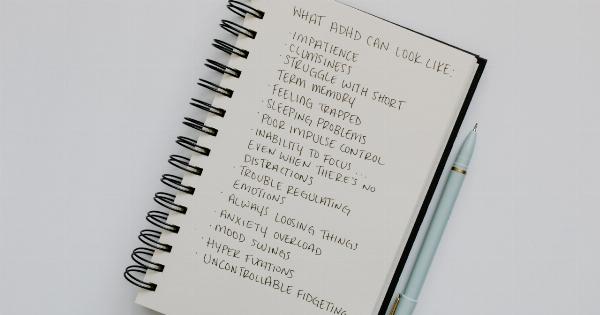Attention Deficit Hyperactivity Disorder, commonly known as ADHD, is a neurodevelopmental disorder that affects both children and adults. People with ADHD often struggle with attention span, impulse control, and hyperactivity.
Managing the symptoms of ADHD can be challenging, but with the right strategies and techniques, individuals can lead fulfilling and productive lives.
1. Establish a Routine
Creating a structured daily routine can significantly help in managing ADHD symptoms. Establish regular times for waking up, meals, work or school, and bedtime.
Having a well-organized routine provides a sense of stability and helps individuals stay focused and on track.
2. Break Tasks into Smaller Steps
Large tasks can be overwhelming for individuals with ADHD. Breaking them down into smaller, more manageable steps can make them feel less daunting.
This approach allows for better concentration and prevents feelings of being overwhelmed, increasing productivity and reducing anxiety.
3. Utilize Calendars and Planners
Using calendars and planners helps individuals with ADHD keep track of important dates, deadlines, and appointments. They can also serve as visual reminders and aids for time management.
Digital tools and smartphone apps may be particularly helpful in organizing schedules and setting reminders.
4. Practice Mindfulness and Meditation
Mindfulness and meditation techniques can be effective in managing ADHD symptoms. These practices promote focus, relaxation, and self-awareness. Regular meditation helps train the mind to be more attentive and improves impulse control.
5. Minimize Distractions
Creating an environment that minimizes distractions can enhance focus and attention.
Some helpful strategies include finding a quiet workspace, reducing visual clutter, and turning off electronic devices or setting them to silent mode during focused tasks.
6. Use Visual Aids
Visual aids, such as color-coded calendars, to-do lists, and task boards, can assist individuals in staying organized and remembering important information.
These visual reminders provide a concrete representation of tasks and deadlines, aiding in planning and prioritization.
7. Implement Regular Exercise
Physical exercise has been shown to have a positive impact on ADHD symptoms. Engaging in regular physical activity, such as jogging, swimming, or yoga, helps release excess energy, improves focus, and reduces impulsivity.
Exercise also promotes overall well-being and can help manage stress.
8. Seek Support and Utilize Resources
Reach out to support groups, therapist, or ADHD coaches who can provide guidance and practical strategies for managing ADHD symptoms. These resources can offer valuable insights, encouragement, and tools tailored to individual needs.
9. Break Up Monotonous Tasks
Monotonous tasks can quickly become tedious and tiresome for individuals with ADHD. Breaking up these tasks by incorporating short breaks or alternating between different activities can help maintain focus and prevent boredom.
10. Develop Healthy Habits
Establishing healthy lifestyle habits can greatly contribute to managing ADHD symptoms. Getting sufficient sleep, maintaining a balanced diet, and effectively managing stress levels are crucial for overall well-being.
These practices create a solid foundation for improved focus, cognitive function, and emotional regulation.






























